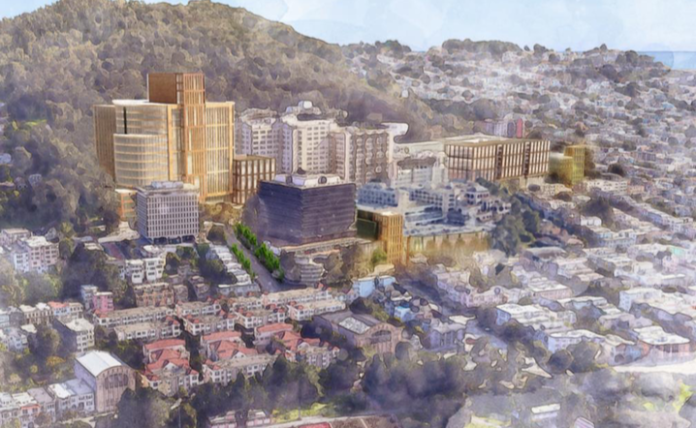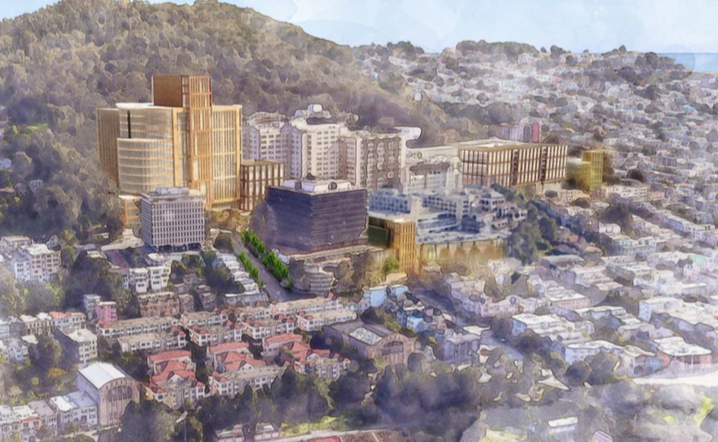
The Planning Commission will hear Thursday/4 a presentation on a massive new development plan for the University of California’s Parnassus Heights campus.
In essence, the school wants to add clinical, lab, and office space the equivalent of another Salesforce building to the congested neighborhood– and critics say the school is not doing anywhere near enough to mitigate the housing and transportation impacts of the plan.

“The University has studiously avoided any real discussion of the jobs/housing balance issues as well any meaningful response to the major impacts on the public transportation of this plan,” said Dennis Antenore, a former planning commissioner who has been part of the UCSF Community Advisory Committee since 1991.
A key issue will be the city’s role in the process: The University of California has a long history of ignoring local planning processes, arguing that as a state agency it’s exempt from city and county rules.
In this case, however, the city has a Memorandum of Understanding dating back to the 1987 that requires UCSF to work with the Planning Commission on all development plans.
There’s also a long-range plan that UCSF negotiated with the city, starting in 1976, which limits the expansion of the campus footprint. That deal, updated in 2014, includes a cap of 3.55 million square feet of office, clinical, and lab space and a maximum daytime population of 13,400 people, including students, staff, and patients.
This new proposal, which is slated to go to the UC regents in the fall, would override that agreement and vastly expand the UCSF hospital and office and research facilities.
The new plan would add 1.5 million square feet of space, including a new 300-foot-tall hospital, with a projected daytime population of 26,500.
The UCSF documents acknowledge the old deal, but say that the institution essentially plans to ignore it.
Part of what’s driving UCSF, according to university memos and documents, is state legislation requiring that hospitals be upgraded to meet new seismic standards by 2030. That, however, does not require any hospital to expand.
As a December 10, 2019 memo from the office of the UC president notes:
Moffitt Hospital was built in 1955 during a different era of medical practices and philosophies. UCSF physicians and staff are currently working in facilities that are outdated, inflexible, undersized, and functionally and clinically obsolete. Many patient rooms and bathrooms are shared; this does not meet patient expectations for privacy and
dignity, and thus does not provide an optimal experience for patients and their families. State seismic law (SB 1953) requires Moffitt Hospital to be structurally retrofitted or decommissioned as an inpatient facility by 2030.
The state law, however, does not require any hospital to expand.
That’s a different agenda: UCSF documents show that the institution wants to grab more market share in the health-care business.
The messaging at times sounds more like a private company than a public university and hospital.
The UCSF plans are also based on the idea that the population of San Francisco and the Bay Area will continue to grow rapidly.
And it includes only 750 housing units, far less than the need that a project of this size will create.
Antenore told me that state law requires UC to pay for the “mitigation” of any impacts it has on a community. In this case, those impacts would include a massive new demand on Muni and on the city’s affordable housing stock. UC tends to write its environmental impact reports to avoid the word “mitigation,” which is something the city will have to watch carefully.
(Of course, all of this is based on a pre-COVID and pre-work-at-home world. Nobody knows how the city’s population will change in the next five years – although many tech companies are now saying that employees can work at home for the long haul, meaning the population may actually fall. Maybe not; it’s hard to plan right now.)
It’s important, though, that the Planning Commission play a role in this process. Neighborhood activists are pushing for a new MOU on this plan, that would include specific agreements that UCSF would pay for the full cost of its impacts.
In fact, the commission, under the 1987 MOU, has a legal right to play a role here. The document states:
UCSF will advise the City in writing of all matters concerning master planning, construction and real property utilization initiated by UCSF which may have an impact on the City. The City Planning Commission will review such proposals and advise UCSF in writing as to the conformance of such development with the Master Plan of San Francisco and Planning Code Section 304.5 (Institutional Master Plans) with recommendations, if any, for amendment to the proposal.
The Planning Commission hearing is informational only, although the public will be allowed to speak.


